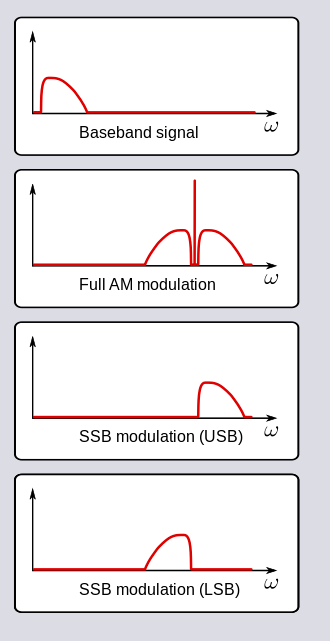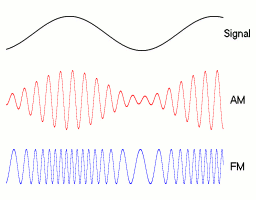A controversial bill that would require all new cars to be fitted with AM radios looks set to become a law in the near future. Yesterday, Senator Edward Markey (D-Mass) revealed that the “AM Radio for Every Vehicle Act” now has the support of 60 US Senators, as well as 246 co-sponsors in the House of Representatives, making its passage an almost sure thing. Should that happen, the National Highway Traffic Safety Administration would be required to ensure that all new cars sold in the US had AM radios at no extra cost.
Removed by mod
You can improvise an AM radio receiver with stuff you have lying around your house.
Not only that, it can be powered by the radio signal itself.
https://en.wikipedia.org/wiki/Crystal_radio
A crystal radio receiver, also called a crystal set, is a simple radio receiver, popular in the early days of radio. It uses only the power of the received radio signal to produce sound, needing no external power. It is named for its most important component, a crystal detector, originally made from a piece of crystalline mineral such as galena.[1] This component is now called a diode.
Crystal radios are the simplest type of radio receiver[2] and can be made with a few inexpensive parts, such as a wire for an antenna, a coil of wire, a capacitor, a crystal detector, and earphones (because a crystal set has insufficient power for a loudspeaker).[3] However they are passive receivers, while other radios use an amplifier powered by current from a battery or wall outlet to make the radio signal louder. Thus, crystal sets produce rather weak sound and must be listened to with sensitive earphones, and can receive stations only within a limited range of the transmitter.[4]
It should be noted though that you’ll need a fairly nearby radio station that is transmitting with a whackton of power.
This is just making me think that there should be a fundamentals of modern technology class in high school somewhere between a shop and physics class. It’d be a nerd elective but by fuck am I that nerd
You had shop?
lol no I’m a millennial
Something between shop class and engineering. Like Technician class. I like it.
I dunno, maybe we need something more General.
Aren’t you being a little Extra?
He’s just advanced, but you’ll never reach that state these days in afraid.
In today’s world, it’s basically impossible to even start out as a Novice.
Tell us about ssb. I also just bought an SDR to get my gas meter readings. Any other cool stuff I should check out?
Single Sideband is basically AM 2.0, so to talk about it in detail, we have to take a closer look at good old fashioned 19th century AM.

The graphic above is from Wikipedia. The top graph, the “baseband” signal, is the audio, aka the signal coming out of the microphone. It’s vaguely what a human voice would look like on a specrograph.
The second graph is what AM looks like. The spike in the middle is called the “carrier.” Let’s say you’re transmitting on 5 MHz with a 10 watt radio. When you push the talk button and then say nothing into the mic, you start broadcasting a 5 MHz wave with a power of 10 watts. A receiver tuned to 5 MHz will hear the background static go away, because you are transmitting a carrier wave that does not modulate much louder than the background noise, you are effectively holding the receiver’s speaker still. A signal coming in strong enough to do that we call “full quieting.”
The carrier carries no information. Another way to look at these graphs is, picture the sine wave. You may have seen something like this before:

That middle waveform represents AM, notice how there’s always some squiggles going through the middle, and it varies toward the top and bottom edges? That’s what the upper graphic is representing, that big center spike is always there for that reason.
You may notice that the two lobes to either side are the same shape as the base band signal; or one of them is, the other is a mirror image. We call these sidebands. That’s actually where the audio is. In the second graphic, you can see how the top and bottom edges of the AM waveform resemble the baseband signal. Turns out, AM radio uses twice as much bandwidth and more than twice as much power to transmit the usable signal.
So what if we built the transmitter to only transmit one of the two sidebands and suppress the carrier and the other sideband? The same audio information goes over the air, and we take up less room on the radio spectrum to do it. What’s more, since we’re transmitting less overall “stuff,” the radio’s power is more focused on the part we do transmit, so a single sideband transmission comes across as “louder” than an equivalent AM transmission.
There are some cool upshots to how SSB works: the first is that the radio uses less power and overall stays cooler. AM (and FM) transmit with their full power all of the time, doesn’t matter if you whisper or scream into the microphone you’re putting whatever power your amplifier is set to out to the feed line. You might be transmitting silence, but it is very loud silence. SSB doesn’t do that; the louder you talk into the mic, the more power goes out the antenna. You aren’t constantly transmitting that carrier, so if your mic goes quiet, so does your antenna. Thus, your transmitter gear takes less power, runs cooler, and if you are on some consumable power source like batteries, you can transmit more effective power for longer.
Even cooler than that is the lack of collisions. If you’ve played with radios much, even listening to music radio stations near the edge of their ranges where you can kind of hear both, you know they interfere with each other. Happens all the time with aviation radios, pilots will transmit on the same frequency at the same time and anyone else listening gets to listen to the psychedelic sounds of two carrier waves interfering with each other. On FM radios usually the louder signal “wins” and the other one just sounds like static or interference under it. SSB doesn’t do this.
If two people transmit at the same time on the same frequency on SSB, a third person listening just hears two voices, just like if two people talked at the same time in a room. Hams hold contests to see who can make contact with the most people from the most places, and folks from somewhere rare will end up asking for contacts, everyone else says their callsigns at once like it’s the floor of the stock exchange, the one station will pick someone he heard to exchange details with, rinse and repeat. It’s 1950’s Discord.
Hams also use this technique to send text back and forth extremely efficiently. If you tune your software defined radio to 14.070 MHz (or use one of several people make available online) you might hear what sounds like several strange warbling whistles that come and go. That is PSK31, a digital text mode designed to use an ordinary PC sound card as a modem, and an ordinary SSB transceiver to send the signals across the air. Using software like FLDigi, you can receive and transmit text over the air, and each text transmission is very narrow in bandwidth. Over a dozen can take place in the same space as a normal voice channel, you leave the radio tuned to 14.070 and choose which transmission to listen to by clicking on them in the waterfall, ie choosing what audio frequency to listen to, which only works using SSB because no carrier collisions.
For all its advantages, there are some disadvantages. You cannot transmit “quiet” with SSB the way you can with AM or FM; so the background static, the “noise floor” is always there. Makes it not so nice for listening to music, which is why you basically only ever see it on communication radios. And it also requires a much more complicated transmitter and receiver while achieving the same or slightly worse audio quality than AM. You don’t see SSB used much in VHF and above because there’s so much room for activities/line of sight limits how far your signal goes so the efficiency advantages of SSB are less important, which is why we tend to use FM (or AM for old shit like airplanes) at wavelengths shorter than 6 meters or so.
100% accurate, thanks for the clear write up. Please stick it up on Wikipedia if you can :)
And I’ll add a bit about Clear Channel AM (unrelated to the billboard advertising company) - there were originally a handful of said stations that broadcast on a few AM band frequencies that are reserved just for them, so their broadcast range is impressive.
One for example is WOR radio in Chicago.
Fun factoid - you can see on very old AM radios those clear channel frequencies marked by a diamond or similar symbol on the dial.
AM is used for traffic advisory and weather conditions by state dots. A car without an AM radio cannot receive those safety critical broadcasts. An AM radio should be required equipment on every vehicle.
Yeah that sounds important
AM radios are also incredibly cheap and simple. It’s just one more source for a digital stereo system connected to a fairly simple circuit. I doubt this costs more than $5 per car to implement.
Oh my god, we’re gonna have to increase the cost of cars and trucks by at least 8000 dollars to cover this egregious and unfair regulation! - Automotive CEO.
AM radio costs nothing to implement, that’s not why it’s absent from me cars. Many modern cars use some form of brushless motor in the power train. The inverters for these motors work at a frequency that interferes with AM radio reception at close range. Manufacturers can add it back to cars (probably by an over the air software update as many radios are SDR), but it’ll just pick up whistling when the car’s moving.
If they oppose it then I’m generally for it, sounds like AM Radio is used to broadcast safety messages on some roads in the USA so it makes sense. Plus, Radios are run of the mill common so it’s not like it’s any sort of barrier to entry.
AM’s lack of fidelity allows it to have increased range, so it’s especially important for emergency situations.
It’s more the modulation type and lower frequency that allows the signal to propagate further. Hilariously, HD radio exists in the AM band in the US, digital transmissions over AM that sound crystal clear. I say hilarious because it seems like it doesn’t make sense but then you have clear audio from something that can be affected by turning on a light, but simultaneously can transmit 6 states away to a little device in your hands without the aid of satellites.
Edit: Although, it really seems that rolling out a new emergency broadcast mechanism would make more sense, I suppose they’re trying to ensure the least common denominator exists across all existing vehicles, since one from the 1930s to the 2020s could receive an AM transmission. Much like how aircraft still have AM radios for voice communications. Unless the AM band in the car is always listening for emergency broadcasts though, adding it is useless, as few would actively listen to it.
Was about to ask if we can transmit digital signal with enough compression and error correction over AM - I guess I wasn’t the first one to think of it 😂.
Not to be that guy, but I wasn’t trying to type out two paragraphs…
Yes the mechanism that transmits AM results in less fidelity. Without an HD receiver…
Do cars really need to have it though? They seem to be the only thing “targeted” to be forced into include something that can receive emergency broadcasts. Why not force homes to be outfitted with an AM radio? Everyone lives somewhere (mostly, unfortunately) but not everyone owns a car. If they really want people to have access to AM radio emergency broadcasts maybe they should supply people with portable AM radios rather than forcing car companies to include it in their cars and increasing the price of vehicles since they will require larger antennae and more wiring than just FM radio or no radio at all.
I have a hard time believing that ¼ of all Americans actively listen to AM broadcasts.
That being said, it’s indispensable for emergency transmissions, and honestly not that complex a component to enable in modern radio systems.
The average American is 38.x years old. There are a lot of children, but the olds still run this country. China is around 37, Germany is around 39. I don’t think that 25% of America listens to AM broadcasts on a regular basis, but I do think at least 1/4 of the population thinks it should still exist.
I was referring to a quote from the article where someone stated that 82 million Americans listen to AM radio.
Coincidentally, I am above average, think that AM radio has utility, and am not opposed to requirements that it be made available in car stereos - though I do not actively tune in.
I’m opposed to it, if the argument is basically “for emergencies”… then putting an emergency radio in would be better. At that point, just lump into the spare kit or something.
Nobody in an emergency is going to think to use something that they don’t use in every day life. Having AM radio in cars is… not going ti be useful. (EAS goes out on FM amd say radio, too, and there’s the WEA sent to cell phones for people younger than dirt.)
and if SHTF, powering a car is going to be difficult. You basically can only rely on the gas in your tank and what you keep around for the lawn mower (if that.).
Most emergency radios are designed with minimal power from the get go (ie battery operated, recharged via hand crank or portable solar, etc.) and can usually be set to automatically come on if the EAS sends an alert.
The justification of “emergencies” is problematic. Most people aren’t going to hunt for an AM radio in an emergency. They are going to their phone/computer. If they want to prop up traditional communication then they should just require both AM and FM AND require the EAS included. With software defined radio this all can be implemented with a single chip and SiriusXM included probably. Just requires the appropriate antennas.
I’m just going to assume there’s somebody that makes a single part, it’s all they make, but it has to go into every am radio; and that person paid off a bunch of lobbyists so they can keep selling that part.
It’s stupid. For emergency alerts, cell phones are vastly more useful, the Wireless Emergency System is far more featured, cell phones are likely in everyone’s pocket, and the system is as reliable as the EAS is.
Any other justification is stupid, and propping up AM is probably the result of said lobbyists…
All of the comments like these don’t understand the word emergency.
There are numerous plausible reasons cell phone towers, computers, and TV will be out in a true emergency.
I mean, hell, cell phone were unusable on 9/11 due to congestion, and even though it was a horrible event, it want an emergency the like of which are possible.
AM is dead fucking simple. Seriously. If you know what you’re doing, you can make a receiver with a wire, a resistor, and a speaker. You don’t even need power to run it.
Requiring the installation of analog AM radios in automobiles is an unnecessary action that would impact EV range, efficiency and affordability (says the lobbyist)
Oh no the vehicle when driving at speed now uses 10001 watts with radio on instead of 10000 watts. Efficiency and range is ruined.
Also the $60k luxury vehicle is now unaffordable when a $1 am receiver is added in the infotainment
The problem isn’t the energy use nor the cost of the am radio, it’s the amount of shielding and other changes that need to be made so the motor and inverter don’t interfere with the am signal. On my bolt there’s an am radio, there’s some ‘stations’ that I can hear the actual sound of the motor.
If standards aren’t set and enforced for that shielding, it won’t just be radio in cars that don’t work. That RFI travels like a tiny broadband (as in multiple frequencies) radio station… because it is. The impacts are compounded the more cars are like that.
Til am radio is still a thing? I know lots of fm radio stations but always wondered why every radio has an am setting, while there is no am stations available.
AM radio is also used for time keeping and weather transmissions for embedded systems that don’t need Internet or heavy computing power (like a clock on your desk or a watch). It’s also good for emergencies. All of which can be passed in analog audio or digitally modulated (or both). Probably not exciting for music, but the fact that it’s there and you can tune into it to find out the weather or traffic is useful.
In some places you’ll see those giant electric warning signs over interstates.
And some times they’ll say “tune to AM 84.2” or whatever, because what drivers need to know can’t be read off a sign.
Ah, good, I assumed it was just for Church Broadcasts or something, but the whole safety requirement makes much more sense. Sucks for the hearing impared, though.








